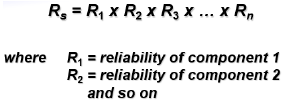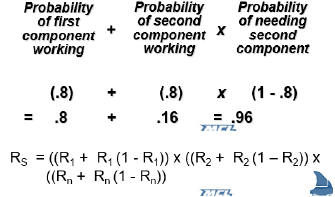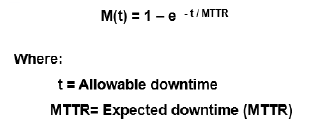TPM MODUL 3
1/93
There's no tags or description
Looks like no tags are added yet.
Name | Mastery | Learn | Test | Matching | Spaced |
|---|
No study sessions yet.
94 Terms
RELIABILITY GOOGLE DEFINITION
the quality of being able to be trusted or believed because of working or behaving well, or how well a machine, piece of equipment, or system works
RELIABILITY 1
Generally defined as the ability of a product to perform, as expected, over certain time.
RELIABILITY 2
Formally defined as the probability that an item, a product, piece of equipment, or system will perform its intended function for a stated period of time under specified operating conditions.
RELIABILITY 3
In the simplest sense, reliability means how long an item (such as a machine) will perform its intended function without a breakdown.
RELIABILITY 4
Reliability is performance over time, probability that something will work when you want it to.
MAINTENANCE AND RELIABILITY
to maintain the capability of the system while controlling costs
MAINTENANCE
all activities involved in keeping a system’s equipment in working order
RELIABILITY (IN MAINTENANCE CONTEXT)
the probability that a machine will function properly for a specified time
MAINTENANCE TACTICS 1
Implementing or improving preventive maintenance
MAINTENANCE TACTICS 2
Increasing repair capability or speed
TACTICS TO IMPROVE RELIABILITY 1
Improving individual components
TACTICS TO IMPROVE RELIABILITY 2
Providing redundancy
FOUR IMPORTANT ELEMENTS OF RELIABILITY
Probability
Performance
Time
operating conditions
PROBABILITY
value between 0 and 1, number of times that an event occurs (success) divided by total number trials)
e.g. probability of 0.91 means that 91 of 100 items will still be working at stated time
PERFORMANCE
Some criteria to define when and how product fails, which also describes what is considered to be satisfactory system operation
e.g. amount of beam collisions, etc
TIME
(system working until time (t), used to predict probability of an item surviving without failure for a designated period of time)
OPERATING CONDITIONS
conditions (environmental factors, humidity, vibration, shock, temperature cycle, operational profile, etc.) that correspond to the stated product life.
CONFLICTS WITH REAL WORLD
Probability
intended function
under stated conditions
prescribed procedures
CONFLICTS WITH REAL WORLD PROBABILITY
Customers expect a probability of 1, “It Works”
CONFLICTS WITH REAL WORLD intended function
The product may be used in unintended ways and still be expected to work
CONFLICTS WITH REAL WORLD under stated conditions
The product may be operated outside of the stated conditions and still be expected to work
CONFLICTS WITH REAL WORLD prescribed procedures
Customers may not have the required tools or skill level and may not follow procedures and still expect the product to work
IMPORTANCE OF REALIABILITY 1
Companies who control the Reliability of their products can only survive in the business in future as today's consumer is more “intelligent” and product aware
IMPORTANCE OF REALIABILITY 2
Liability for unreliable products can be very high.
IMPORTANCE OF REALIABILITY 3
Complexity of products is ever increasing and thus challenge to Reliability Engineering is also increasing.
IMPORTANCE OF REALIABILITY 4
Products are being advertised by their Reliability Ratings.
Reliability
can be considered as ”Quality over time”. Customers frequently use the terms ”quality” and ”reliability”. We need to understand what they expect.
Measurement of reliability
is related to failure rates, number of failures, warranty cost etc. Thus, reliability is experienced by the customers when they use the product.
Quality Level
is measured in terms of defect levels when the product is received as new
Quality and reliability
both can have significant impact on Safety.
Quality defects and failures
both can adversely affect safety of user, bystanders and equipment.
QUALITY, RELIABILITY AND SAFETY
Some quality defects can lead to unreliable and/or unsafe product.
examples of how unreliability can affect safety
Failure of automobile steering system, brake system, axles
Short circuit in electrical equipment
Failure of safety valve in a pressure cooker, leakage of regulator of an LPG cylinder
Poor reliability of a bridge
EFFECTS OF FAILURE
Operation
Reputation
Profitability
Dissatisfied customers
Idle employees
Profits becoming losses
Reduced value of investment in plant and equipment
Reliability Engineering
is concerned with analyzing failures and providing feedback to design and production to prevent future failures
Reliability and maintainability engineering
attempts to study, characterize, measure, and analyze the failure and repair of systems in order to improve upon their operational use by increasing their design life, eliminating or reducing the likelihood of failures and safety risks, and reducing downtime thereby increasing available operating time.
Reliability engineers usually speaks of
Failures Causes
Failure Modes
Failure Mechanisms
HOW DO PRODUCTS REALLY FAIL
DESIGNED TO FAIL
MANUFACTURED TO FAIL
ASSEMBLED TO FAIL
SCREENED TO FAIL
STORED TO FAIL
TRANSPORTED TO FAIL
OPERATED TO FAIL
Two common types of failures 1
Sudden failure (no indicators)
Two common types of failures 1
Degradation (gradual wear out)
FAILURE
is an event when an item is not available to perform its function at specified conditions when scheduled or is not capable of performing functions to specification.
FAULT
The part of the item which must be repaired to prevent a failure
FAILURE RATE
The number of failures per unit of gross operating period in terms of time, events, cycles
TYPES OF FAILURE OF ITEMS
RANDOM
DEPENDENT
DEPENDENT FAILURES
CONSECUTIVE
FAILURES OF IDENTICAL ITEMS
DESIGN
ENVIRONMENTAL
FUNCTIONAL
FAULT CLASSIFICATION
PHENOMINOLOGICAL CAUSE
NATURE
PHASE OF CREATION OR OR OCCURENCE
SYSTEM BOUNDARIES
PERSISTENCE
PHENOMENOLOGICAL CAUSE
PHYSICAL
HUMAN MADE
NATURE
ACCIDENTAL
NONMALICIOUS INTENTIONAL
MALICIOUS
PHASE OF CREATION OR OCCURENCE
DEVELOPMENTAL
OPERATIONAL
SYSTEM BOUNDARIES
INTERNAL
EXTERNAL
PERSISTENCE
PERMANENT
TEMPORARY
Reliability, Availability, Maintainability, Safety and Quality
are what the Customer says they are, not what the Engineers or the Designers say they are.
Safety
is the probability that a system will either perform its functions correctly or will discontinue its functions in a manner that does not disrupt the operation of other systems or compromise the safety of any people associated directly or indirectly with the system.
Maintainability
is defined to be the probability that a failed component or system will be restored or repaired to a specified condition within a period of time when maintenance is performed in accordance with prescribed procedures -M(t).
AVAILABILITY
is defined as the probability that a component or system is performing its required function at a given point in time when used under stated operating conditions -A(t).
RELIABILITY
defined to be the probability that a component or system will perform a required function for a given period of time when used under stated operating conditions -R(t).
AVAILABILITY
Machines with more frequent but less severe breakdowns are better in terms of process stability and inventory cost than machines with less frequent but more severe breakdowns.
Accurate assessment of availability and variability calls for high data integrity.
Must show all downtime for internal setups and failures
MAINTAINABILITY
is the measure of the ability of a system or item to be retained or restored to a specified condition when maintenance is performed by qualified personnel using specified procedure and resources
SPECIFIC PRINCIPLES OF MAINTAINABILITY
Reduce life cycle maintenance costS
Reduce the amount, frequently and complexity of required maintenance tasks.
Reduce mean time to repair (MTTR)
Determine the extent of preventive maintenance to be performed
Provide for maximum interchange ability
Reduce the amount of supply supports required
Reduce or eliminate the need for maintenance
Consider benefits of modular replacement versus part repair or throwaway design
SPECIFIC PRINCIPLES OF RELIABILITY
Maximize the use of standard parts
Use fewer components for performing multiple functions
Design for simplicity
Provide adequate safety factors between strength and peek stress values
Provide fail-safe design
Provide redundancy when required
Minimize stress on components and parts
Use parts and components with proven reliability
BATHTUB CURVE
The failure rate is expected to vary over the life of a product
A-B Early Failure / Infant mortality / Debugging / Break-in
Teething’ problems. Caused by design/material flaws
Eg: Joints, Welds, Contamination, Misuse, Misassembly
B-C Constant Failure / Useful life
Lower than initial failure rate and more or less constant until end of life
C-D End of life failure / Wear out phase.
end of life Failure rate rises again due to components reaching
eg.: Corrosion, Cracking, Wear, Friction, Fatigue, Erosion, Lack of PM
Reliability management
concerned with performance and conformance over the expected life of the product
RELIABILITY
______ of a system is often specified by the failure rate λ.
λ
failures per time unit (in a collection of systems)
bath-tub curve
For most technical products (incl. embedded systems), λ(t)
RELIABILITY MEASUREMENT FORMULA

MTBF
Mean Time Between Failures - The average time between failure occurrences. The number of items and their operating time divided by the total number of failures. For Repairable Items
MTTF
Mean Time To Failure - The average time to failure occurrence. The number of items and their operating time divided by the total number of failures. For Repairable Items and Non-repairable Items
MTTR
Mean Time To Repair - The average time to restore the item to specified conditions.
Improving individual components

Providing redundancy

DESIGN
The most important aspect of reliability is the design.
It should be as simple as possible.
The fewer the number of components, the greater the reliability.
Another way of achieving reliability is to have a backup or redundant component (parallel component).
Reliability can be achieved by overdesign.
The use of large factors of safety can increase the reliability of a product.
When an unreliable product can lead to a fatality or substantial financial loss, a fail-safe type of device should be used.
The maintenance of the system is an important factor in reliability.
PRODUCTION
The second most important aspect of reliability is the production process.
Emphasis should be placed on those components which are least reliable.
Production personnel.
TRANSPORTATION
The third most important aspect of reliability
packaging
shipment
Performance of the product by the customer is the final evaluation.
Good packaging techniques and shipment evaluation are essential.
AVAILABILITY
It is a time-related factor that measures the ability of a product or service to perform its designated function.
The product or service is available when it is in the operational state, which includes active and standby use.
This measure of availability might be preferable because it gives incentive to reduce Both MTTR and internal setup time.
Setup time and MTTR are often interrelated to the extent that poorly maintained Equipment is harder to change over and adjust.
OPERATIONAL AVAILABILITY
MTBM-Mean time Between Maintenance
MTD- Mean Downtime

INHERENT AVAILABILITY
MTBF- Mean time Between Failures
MTTF- Mean Time to Repair

Availability differ from reliability.
Reliability involves an interval of time, while availability at an instant of time.
availability of a system depends
depends not only on how frequently it becomes inoperable but also how quickly it can be repaired.
system
can be highly available yet experience frequent periods of inoperability
AVAILABILITY AND MAINTAINABILITY
For long-lasting products and services such as refrigerators, electric power lines, and front-line services, the time-related factors of availability, reliability, and maintainability are interrelated
MAINTAINABILITY FORMULA

MTBMA
Mean Time Between Maintenance Actions including preventive and corrective maintenance tasks
OBJECTIVES OF MAINTAINABILITY 1
To influence design to achieve case of maintenance thus reducing maintenance time & cost.
OBJECTIVES OF MAINTAINABILITY 2
To estimate the downtime for maintenance which, when compared with allowable downtime, determines whether redundancy is required to provide acceptable continuity of a critical function
OBJECTIVES OF MAINTAINABILITY 3
To estimate system availability by combining maintainability data with reliability data.
OBJECTIVES OF MAINTAINABILITY 4
To estimate the man-hours and other resources required for performing maintenance, which are useful for determining the costs of maintenance and for maintenance planning
ADVANTAGES OF MAINTAINABILITY PREDICTION 1
It highlights areas of poor maintainability which require product improvement, modification or change of design.
ADVANTAGES OF MAINTAINABILITY PREDICTION 2
It highlights areas of poor maintainability which require product improvement, modification or change of design.
PROBABILITY OF REPAIR WITHIN THE ALLOWABLE DOWNTIME FORMULA
